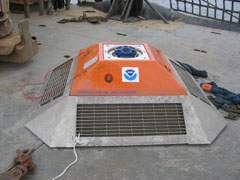Current Profiler
Currents Tutorial
An Acoustic Doppler Current Profiler (ADCP) measures ocean currents using the principle of “Doppler shift.” If you have heard a train whistle in the distance, you are familiar with Doppler effect. As the train gets closer, the whistle pitch gets higher. As the train moves away, the whistle pitch gets lower. The change in pitch is proportional to the speed of the train.
An ADCP follows the premise of the Doppler effect. It emits a series of high-frequency pulses of sound that bounce off of moving particles in the water. If the particle is moving away from the instrument, the return signal is at a lower frequency. If the particle is moving toward the instrument, the return signal is at a higher frequency. Because the particles move at the same speed as the water that carries them, the speed of the water’s current can be determined.
Currents Lessons
- Welcome
- Tidal Currents 1
- Tidal Currents 2
- Waves
- Longshore Currents
- Rip Currents
- Upwelling
- The Coriolis Effect
- Surface Ocean Currents
- Boundary Currents
- The Ekman Spiral
- Thermohaline Circulation
- The Global Conveyor Belt
- Effects of Climate Change
- Age of Exploration
- What is a "knot"?
- Shallow Water Drifter
- Deep Ocean Drifter
- Current Profiler
- Shore-based Current Meters
- How Currents Affect Our Lives?
- References
- Roadmap to Resources
- Subject Review

